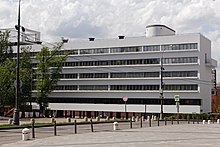
Back Pilotis Catalan Pilotis German Pilotis Spanish Pilotis French ピロティ Japanese 필로티 Korean Pilotis Polish Pilotis Portuguese Pilotis Swedish





Pilotis, or piers, are supports such as columns, pillars, or stilts that lift a building above ground or water. They are traditionally found in stilt and pole dwellings such as fishermen's huts in Asia and Scandinavia[1] using wood, and in elevated houses such as Old Queenslanders in Australia's tropical Northern state, where they are called "stumps". Pilotis are a fixture of modern architecture, and were recommended by the modern architect Le Corbusier in his manifesto, the Five Points of Architecture.
- ^ Sweden: a single photograph of such houses, whose caption calls the supports pilotis.